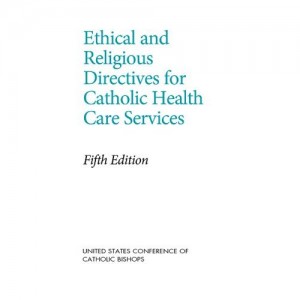Controversies concerning Catholicism and healthcare have been front page staples over the last few years. Currently, it is the ACLU is suing the United States Conference of Catholic Bishops on behalf of Tamesha Means, who suffered from an acute infection and tragically lost her baby. The lawsuit claims that Ms. Means was denied adequate medical care as a result of the Ethical and Religious Directives for Catholic Healthcare (ERDs), a set of directives promulgated by the Bishops to guide Catholic healthcare. The ACLU accuses the hospital of negligence by failing to offer termination of pregnancy as an option. While the ERDs do forbid Catholic hospitals from discussing or suggesting abortion or the intentional termination of a pregnancy, this alone does not constitute medical negligence. Instead, this case provides an example for the way in which Catholic moral theology, especially through the principle of double effect, may offer greater public understanding of the guidelines that govern Catholic hospitals.
Ms. Means was 18 weeks pregnant when she suffered from a premature membrane abruption – her water broke. Within 72 hours of abruption, she delivered her baby who died after 2.5 hours. There is much we do not know that would be needed to determine whether or not Ms. Means has a legitimate claim of negligence with respect to those aspects of her care (and the question of what information she was given regarding her condition). For example, was she given appropriate antibiotics and corticosteroids – which are the basic standard of care in cases of premature rupture of membranes? The answer is unknown as all of this information is protected by HIPAA.
When Ms Means returned to the hospital with a 100.4 fever and acute chorioamniotitis diagnosed, standard medical care involved inducing labor to remove the amniotic fluid. The claim is that she was not induced or medically treated during the miscarriage because of the ERDs and that when questioned on the failure to induce in 5 cases; the Vice President of Mission Services referred to the ERDs. While each case must be evaluated individually, claiming the ERDs automatically prevent inducing labor is a misreading of the ERDs by failing to apply the principle of double effect.
At the heart of this controversy and lawsuit are the ERDs 45 and 47 which establish the guidelines regarding abortion and maternal fetal conflict. While ERD 45 offers an unequivocal prohibition of all directly intended termination of a pregnancy and all procedures “whose sole immediate effect” is the death of the fetus. It is ERD 47 which applies to this case:
“47. Operations, treatments, and medications that have as their direct purpose the cure of a proportionately serious pathological condition of a pregnant woman are permitted when they cannot be safely postponed until the unborn child is viable, even if they will result in the death of the unborn child.”
Considerable ink has been spilled as moral theologians, hospital ethicists, and healthcare professionals apply these two directives to complex and heart wrenching cases. Too often, the ERDs are attacked without attention to the entire set of directives for such cases. In this particular medical condition, one does not come to an impasse – early induction of labor even though it is before viability falls under the principle of double effect.
The Principle of Double Effect guides moral decisions where there is both a good effect and an unintended bad effect (this principle is central for both bioethics and just war theory). Healthcare ethicists Benedict Ashley, OP and Kevin O’Rourke, OP lay out four elements to double effect, which I then apply to this case
-
The directly intended object of the act must not be intrinsically contradictory to the true ultimate goal of human life. In this case, the goal/intention is to save the woman’s life.
-
The intention of the agent must be to achieve the beneficial effect and as far as possible to avoid the harmful effects. Here, the intention is to remove infected amniotic fluid; one would save the child’s life if one could. If this rupture occurred post-viability both mother and child would be saved through the induction.
-
The foreseen beneficial effects must be at least equal to the foreseen harmful effects. The moral value of the mother’s life equals that of the child’s life.
-
The beneficial effects must follow from the action at least as immediately as do the harmful effects. It is the removal of the amniotic fluid/infection not the child’s death that is the means to save the woman’s life. In fact, the baby lived for 2.5 hours, a factor which supports the approach of the ERDs to consider both mother and baby as patients.
In many Catholic healthcare textbooks, the case of early induction due to serious infection (acute chorioamniotitis) is an example used to teach the principle of double effect in medicine. The ending of the pregnancy is neither intended nor the desired effect when treating a woman 18-23 weeks with acute chorioamniotitis. The unborn child is not considered the pathogen nor was the child directly acted upon. In fact the child lived for 2.5 hours. The ERDs do not prohibit early induction in these cases of acute chorioamnionitis as it does not constitute a direct abortion.
Ms. Means illness, the death of her child, and the trauma she suffered are all great tragedies. There are many important questions to be raised by this case (failure to admit, informed consent, bedside manner, and others which must be examined for negligence) but the ERDs are not to blame. The ERDs are a morally and medically grounded set of directives to guide the important health ministries of Catholic groups (the complexity of their authority has also been addressed by Cathy Kaveny). Much of the data being cited by the ACLU as evidence, if anything, indicates that while there is widespread knowledge that the Directives exist, familiarity and knowledge of them is ambiguous at best among clinical practitioners.
Failure to give the patient complete information about one’s condition is a serious breach. Failure discuss abortion does not constitute medical negligence and the ERDs do not provide for an easy scapegoat for the ambiguities of this complex case. The ACLU and others are concerned with the growth of Catholic healthcare and in this battle – it is disheartening to see the pain and suffering of a grieving mother being exploited. For those so unhappy with the ERDs and Catholic healthcare, it is worth pointing out that the ire and indignation too often only extends as far as suing Catholic hospitals and not to providing alternative healthcare institutions for under-served populations.






Hi Megan
Thanks for the post, which is helpful, especially in showing how the Ashley-O’Rourke account of double effect would apply in such cases, leading to seemingly more reasonable conclusions.
This is so, precisely because their way of handling the first condition of PDE makes clear that this decisive first step is to determine the intended object of the human act in question. But the problem surrounding the ERDs is that other moral approaches are at work, namely physicalism. I’ll say more about this after mass.
Bill
Here is an addition to my prior post.
As I wrote previously, I think the Ashley-O’Rourke account of the PDE can work in these cases (of “vital conflict”) because it highlights the centrality of determining the moral object (before one can apply the other conditions of PDE). In requiring moralists to assess first the object, their account aligns with no. 78 of Veritatis splendor, which begins with the assertion that “The morality of the human act depends primarily and fundamentally on the “object” rationally chosen by the deliberate will, as is borne out by the insightful analysis, still valid today, made by Saint Thomas.”
Moral theologians and philosophers are well aware that VSs reference to Aquinas’s approach to the object, especially in light of such notions as his “proximate end,” has resulted in several years of debate on the meaning of this teaching, mostly between those I would describe as following the direction encouraged by the encyclical and those trying to defend a more “physicalist approach” (of the “commentatorial” and manualist tradition with its more stringent conclusions, like the savable mother must be left to die in cases of vital conflict). I would argue that the best account of the approach encouraged by the encyclical is here http://www.pcj.edu/journal/essays/18-2%20Rhonheimer.pdf, including a response to critiques from a more physicalist perspective. My point here is that there is a background debate about the reception of VS that relates directly to the interpretation of the ERDs.
Now the key point for this discussion concerns how these debates on moral theory relate to the different understandings of “direct abortion,” but I’ll save that for another time.
Bill